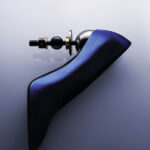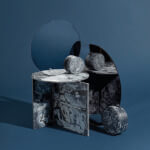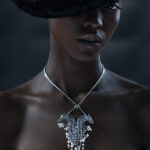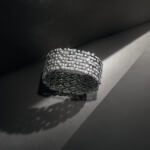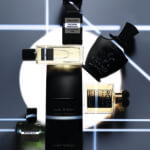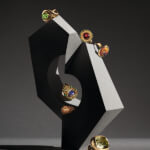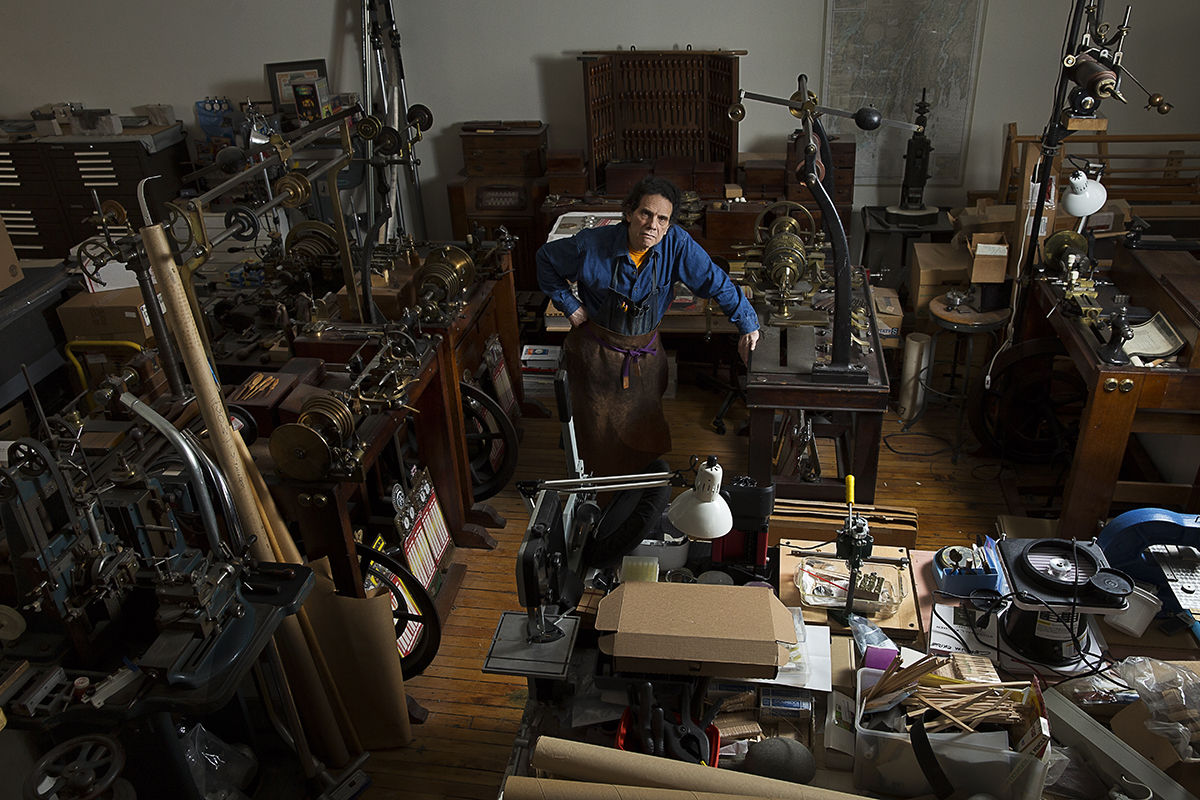
Long Read
Following on from her first book Coveted: Art and Innovation in High Jewelry, Melanie Grant examines the evolution of jewellery as art with a new five-part series created during lockdown with some of jewellery’s modern masters for The Goldsmiths’ Company. This is Part I.
Daniel Brush on Gold
It Began With an Etruscan Bowl
When I was thirteen years old I had an epiphanic moment. I was at the V&A museum in London with my mother at the end of an eleven-day trip through places like Lichtenstein and Luxembourg and I was exhausted. We were at the jewel vault having passed through this iron turnstile and we were looking at all this stuff. Then near the back, on the left there was this small golden bowl and it pinned me. It was stunning.
Back home in Cleveland Ohio I used to glue model cars together and sailing ships or play football with my friends but suddenly I was standing here, staring at this bowl with little balls all over it and I knew at that moment I had to make something like that in my lifetime. Thinking back it was an overwhelming revelation and of course it roosted in my mind for 20 years.
I did some research. The bowl was found in Palestrina, a small city near Rome and was made around 700 BC. It was small, about four inches wide and three inches high and I studied its history while I was teaching at Georgetown University in the 1970’s. I would go to Dumbarton Oaks (now part of Harvard) as they had this incredible library and collection of pre-Columbian, also Roman, Greek and Byzantine gold. The roosting had taken over.
I found out it was most likely hammered from a sheet of gold which was probably not refined but alluvial gold. It was raised very much the way a silversmith raises a tea or coffee pot into somewhat of a melon shape and had these patterns of gold granules, rectangular labyrinth configurations and interlocking loops. It was an extraordinary creation, effortless in fact with an ethereal lightness of spirit. Just as the Roman philosopher Pliny said as if little girls with little fingers were laughing between themselves before lunch and applying the granules. It had insouciance.
After reading all the books and after traveling all over the world and thinking about granulation endlessly, I wanted to delete everything I had learned and become a little girl in Etruria. It was the only way I could ever attempt to be as good as they were. In fact, I didn’t even come close. Their lightness of spirit was in the work and I still had my classical Western education to deal with which I couldn’t get rid of entirely, but anyway this is part of my background and of my thinking.
Gold is Emotional
The first gold piece I had made was my wife Olivia’s wedding ring. I bought an ounce of pure gold for $35 and from that out came a Hercules knot. I love Greek gold. Gold for me is a magical mystery tour. Olivia and I had a purpose which was to see how people did things so we visited the workshops of Mumbai, we went to Russia, through Europe, to the inner sanctum workshops of the great French Maisons and in all cases what we witnessed were traditions being passed down through artisans and craftspeople.
By chance we became friends with Dr Oliver Sacks. He was an idiosyncratic and brilliant medical doctor and scientist. He had endless curiosity apart from his expertise in Parkinson’s and Tourettes. He would come to the studio on Sunday mornings, bringing our son Silla, Oliver biscuits and eventually we would slip into my studio to play with gold. I taught him how to granulate. We melted gold for the fun of melting gold, we watched it turn from solid to liquid, we watched it chill and change its surface.
But I’ve got to tell you, when it melts, when it goes from its grain, to a puddle, to red hot, to white hot on charcoal (cherry wood charcoal) a purple glow comes off of it, it radiates off the metal. And whether I add romance to it or not, it is so beautiful…magical in fact. Even now, fifty years later, I still feel it. Dr. Sacks would laugh uproariously when he saw the purple glow, he couldn’t explain why and he was a much better scientist than I was. The visual poetry that comes off that metal affects my emotions really deeply.
On our travels Olivia and I stood in Galla Placidia’s tomb in Ravenna and watched the flickering of the light against the gold tesserae. We walked through the streets of Florence as the city was glowing with sunlight reflecting off the Church domes at dusk. The attraction we feel for gold may be it’s warmth; it’s colour in connection to the sun or is it the patina that occurs from all the scratches and dents inflicted over the years?
I don’t know but from time to time, especially now, during the pandemic, I catch myself trying to find equanimity of spirit by holding in my hand 20 ounces of pure gold grain and letting it sift through my fingers. Just to enjoy the feeling of something bigger than myself. Why do I do that? Maybe, because I can rely on it. I can’t rely on the uneasiness of the everyday but when that gold sifts through my fingers, it makes me feel good. It’s not about the monetary value, it’s about the history and the colour which is embedded into the soul of it. That’s romantic and I can’t help it. I find it transformative rather than transactional.
Industrial Materials
I’ve hovered, walked and paced around the studio for 45 years. Olivia is over there and I’m over here. She works with fabrics, patterns and sewing machines and so thread clings to her via static electricity. She’s always peeling it off with those sticky roller tapes so we aren’t totally contaminated as we eat our peanut butter sandwiches. A decade ago I thought it would be hysterically funny to make steel threads set with Mogul diamonds of around point six millimetres (as small as pinheads) and when she least expected it, magnetize them onto her clothing. I waited and waited for her to do the sticky roller thing but they wouldn’t come off. She laughed so hard that I spent the next two years making 116 more of them and at one point she wore them all at once, those steel and diamond threads. They ended up in a retrospective I had at the Museum of Arts and Design in 2012, in a frame on the wall as a kind of calligraphic poem.
I really saw them for the first time in that frame because it wasn’t about the laughter or the steel or the diamonds. It was really a love poem to my wife and I understood that for the first time when I saw them on the wall. They are still all together. They won’t be broken up like a set of baseball cards to be sold.
When our son was a little boy, he loved dipping animal crackers into milk and playacting Noah’s Arc. Because of him or as a diversion for me (because let’s face it, how much can I think about the existential drama of Samuel Beckett?) I made him some toys out of Bakelite. Over the years some of those ‘critic’ types have complained “How can you be a serious artist and make these bears, afghans and poodles?” but I made them all for my son to play with. In 2007 the Bakelite animals were magnetized onto a board and framed on the wall. They then became a more recognisable form of art and that segmentation or hierarchy of art continues to frustrate Brush.
Jewellery as Art, The Battle Continues…
Is jewellery accepted as art in the art world? No of course not. There may be people who buy art and who wear jewellery but is it on an equal footing? No! In the endless Instagram posts, the advertising, and in every webinar we talk about jewellery as memorializing a life event. Wearing it to a party and ultimately its enhancement to the wearer. Is an important painting ever discussed relative to its placement next to the sofa?
The fine arts are not spoken about in terms of usage and that is the difference. I like the idea of scale versus size. If I make a huge steel sculpture and set it on the side of a mountain, it is necessarily very large but if I hold something in my hand small in size it can still have immense scale. It has the scale of history. The scale of the ethereal, the scale of the romance you bring to it. Many small things I have held in my hand are pieces of jewellery.
A jewel in a box that is never worn is still called a jewel with all of its connotations, because it carries with it a function. Jewelry displays wealth, power and status. Recently, and I am not sure whether it works or not, functional jewellery such as necklaces, rings, and bracelets are being hung on the wall. I don’t think it works. In fact, I think it is a sophomoric clever attempt to gain some equal footing with painting.
Monetary concerns became prevalent but above all, our area of greatest challenge is the pejorative term ‘decorative arts’. The museums are called The Musée des Arts Décoratifs. We celebrate classes in the decorative arts. In almost every instance, jewellery, precious metals and stones are placed in that area and separated from the so-called more elevated, fine arts. One is about ideas and the other about artisan, craftsmanship, value and materials. It’s never going to have an equal platform.
These separate curatorial departments have been created for ease of consumption. The fine arts decide they aren’t going to discuss materials – paint canvas and linen but in the decorative arts we’re merrily explaining the application of precious metal, precious stones, artisanship and craftsmanship. All of that has to go away. I get up in the morning and I will listen to Miles Davis, at the same time as a string quartet while eating peanut butter and some extraordinary four-star chef’s food. I don’t like filing cabinets but it makes everything easier.
For me it’s been “he’s a sculptor, what the hell is this jewellery?!” Then we go back and forth and it becomes tiring. This way of working is not working (for jewellery) in America, Europe or the UK but it’s a little better in Asia I think. I was talking with a friend who has been in Finance for thirty years and I was giving him all this advice about what museum to see or movie to watch. He then tells me he works six days a week from 5am – 10pm when the markets are open. He has hardly any time off so culture as a leisure activity has been narrowed and focused to make it easier for him. It’s going to take a long time if ever for that to change.
To Make or Not to Make
I come to this as an artist and I believe in the solitary nature of the studio. I’m fighting in the ring and it’s a blood sport. To find your voice you have to struggle and I think that voice comes out of a pile of garbled statements, of mumbled techniques. It’s a battle to have your voice heard. I don’t know what it means to design something and then to hand it to someone else or to let a computer assist me in my work. I am alone. I put on the boxing gloves. I struggle and inch forward, I yell. All I’m trying to do is find a whisper of what it means to be an artist. The work is never done. I might stop when the momentum stops but I don’t know any other way of it at all. You know, I’ve been doing it this way since I was a boy. So do I make my own things? Isn’t that what you’re supposed to do?
People have asked me this over and over. If you were an architect, would you really have to lay all the stones? Well, if I was I probably would. I think you’re supposed to slip on the red paint, fall down and break your knee. I think you’re supposed to, by yourself, melt the gold and look at the purple glow. I think you’re supposed to hold your work in your hand, tenderly and protected because you struggle to hear its voice. I don’t understand anything else.
Thirty years ago I was introduced to Tiffany & Co. I went over there and had a meeting I’ll never forget with the head of design. She had some drawings her design studio had made peeking out a little bit from a portfolio and I said, ‘Oh, what are they?’ She immediately tucked them down into the portfolio so I couldn’t see a damn thing and I thought, how bizarre is that?! I mean, really. That design didn’t struggle on it’s own and that’s why it didn’t come up like a magic trick. It was the product of many people working towards a decision to make a saleable product. I don’t think like that.
I’m not trying to say that’s bad. It’s just not me. I don’t get up in the morning and say, “what am I going to sell?” or “What do women want?” I don’t even know what I want! I don’t want anything. I want the voice to become exposed and survive even if it’s an inaudible whisper, that’s all I know about. So I don’t think in terms of collaboration because I don’t want the whisper to get diluted.
I’m trying to remove all the ego in the work. I’m trying to have it make itself. I want to let it come in, let it come out and have virtually no attachment to it. I’m a terrible craftsman. I’m a terrible artisan because I don’t want to be aware of it. I want it to flow so effortlessly, as language, as being just totally clear, clean, and transparent with no ego attached. It just somehow came, went and is gone, like the wind. Yet people have said in the last thirty years “Oh my God, you’re like a master of granulation!”. I am shit at granulation, terrible at it. When you look at that bowl in the V&A. It is breathtaking. I am breathless.
Evolving…
I think that all the drawings and all the sculptures and all the jewels I’ve done in all the years in some ways are all the same. What’s different is me. Some of the pieces have a youthful posture and some have a more mature posture. I can see it in the jewellery I made fifty years ago, compared to jewellery I made yesterday.
Why does it look different? It’s not the cleanliness of its craftsmanship. It’s not the selection of materials, colours or composition but as I get older more and more elements have been deleted from it. It has gotten less youthful, there is less beating my hands to my chest and less ego. When I was younger, I wanted to be the best. Get out of my way, I don’t care what it takes, I don’t care what I have to do. Nobody is going to touch gold the way I do. And then I got older and that’s not important to me anymore. I don’t find competition with others. I find as I said, the blood sport in being an artist.
I get up in the morning and pace the floor, sweep the floor, worry, wander, think, study, delete and somehow, in all of that I think that something might happen. I remember listening to a teacher of mine when I was at The Carnegie Institute of Technology; say that the goal was for my mind to be an empty room. And within that empty room, anything was possible. I loved that. I’ve always tried over the years to make more and more and more of an empty room. So all the things I studied, they came in, they came out, and I was just sitting there somehow letting it pass through me.
When I was a child my parents invited some friends over for dinner. My parents sold children’s clothes and they met them via the store. I was an only child and I was kind of quiet and during dinner I looked down at the woman’s arm. She was wearing a flowery dress with short sleeves and on her arm was a tattoo with numbers. She saw me looking at her arm and in a really soft-spoken way she said something I’ll never forget. She put her arm round my shoulders and said “make sure in your life, you paint your own colour”.
The classic thinking about getting ahead is I do this or I do that, I’m going to progress. Generally as I learned from teaching at university, the job of the school was to fit their bright students into the job market. Parents wanted to pay for an education that provided work and upward mobility. Of course I understood that. But, one main reason I retired from teaching and returned my tenure after I took a sabbatical was that I did not think it was the right way to go. I felt my job should be to encourage endless spirals of confusion to help students think critically, to encourage questions, to not only look from left field at a situation, but to create a whole new vantage point for the situation. I am not sure this can happen at 20 years old. I think it is a life pursuit to always be uncomfortable, to always search, to always study, and to question everything. And in all the cacophony of information, I think, at least from my own experience, there are moments of epiphanic clarity.
I’m 74 years old now and I’ve realised that learning to live one’s life by listening to one’s life is important. There is no past, no future, just the present. I’m reading, I’m studying, I’m doing, I’m working, I’m worrying, I’m wondering, I’m walking through the studio and I’m sleeping. What would I do differently? I don’t have time to do anything differently. I have to do what my life tells me to do.
Understanding Greatness
I’ve been thinking about Vermeer, thinking about Lalique, thinking about Brancusi and thinking about Barnett Newman for sixty-five years. I think about Beckett and James Baldwin. I think about William Carlos Williams and A.O. Scott. Who is the greatest steel / gold inlayer ever? Was it Nicholas-Noel Boutet, Napoleon’s armourer? Who understood steel? I’m like a kid.
Masamune, a great 14th century Japanese sword maker, didn’t ever sign his work. I remember talking to the Chief Curator of metalwork at the Metropolitan Museum, as he placed in my hands the most valuable sword in North America. In the darkness of the room, in the basement of the MET he said “Daniel, can you see the clouds parting in the steel?” and I said “I’m trying”. He could see the clouds parting and therefore he knew it was Masamune. He said he had the least amount of ignorance in the world about Japanese historical blades.
I’m a member of the Society of Mechanical Engineers. I have an extensive library of all the thinkers in science and engineering and do you know who I admire the most? The unnamed people, the ones you never see. You don’t even hear about them but I know with all my heart and soul that they are working. They’re obsessed with their work. They’re struggling with the work and the work is surviving. That is who I admire.
What is to Come
I’ve been working on a project for over thirty years and I guess with the pandemic I’ve been crushed into working on it more. It is entitled ‘The Walk of a Thousand Miles’. When I was at Carnegie, I remember studying the Tendai monks of Buddhism. There have only been forty-eight of them since the late 1800s. This tradition started somewhere around the eighth century and they adhere to a rigorous training regimen that starts in their late twenties.
Rising, sleeping, eating, walking, cleaning, doing chores, praying in and around physical and strenuously, almost impossibly challenging conditions. They feel it puts them on a path to enlightenment. I’m working on a three volume book which will have in it photographs of the work I did to make each individual volume. My purpose is to make a visual poetry book. All the sculptures are made solely for the purpose of the book. All the pieces are hand-sized in steel, gold and platinum. Doing the work over the past thirty years is in my way to share the experience of the monks.
The first book is complete with forty pieces and is called ‘Cantos for a Thousand Miles’. The second book is complete with twenty-seven pieces, it was finished a couple of years ago and is called ‘Reflections on a Thousand Miles’. The third book is on going with no end in sight called ‘Poems for a Thousand Miles’.’
I like to think somehow that at any one time, one of the pieces could be with one of the monks as they walk fifty miles that particular day with no food or drink. They could reach into their pocket, hold a piece in their hand and let their thinking of it come in and go out before putting it back into their pocket. If I understand any of it, for myself, what they are trying to arrive at in Japanese is called ‘Mushin’ or No Mind. It’s a place of no ego. All of their history comes in and goes out and somehow they are totally in the present moment. Pure, aware and totally clear.
Making this stuff is meaningful, obsessive and all consuming for me. Thank god for Olivia sharing the studio with me all these years to give me equanimity of spirit. I keep looking, keep finding, keep listening, keep trying. To find out what this strangeness is all about. I’d rather be a goldsmith than a jeweller. I’m really just some kid from Cleveland, Ohio who couldn’t build a model car. I’m thankful that anyone has looked at anything I’ve made. It’s very important to somehow feel that you’re not completely alone. I’m now part of the great tradition of The Goldsmith’s Company and I find that so romantically beautiful compared to “Well, you know, I made a fortune on Wall Street.” That doesn’t cut it for me. This is a bigger platform. It’s like in all of history, I’m seeing in melted gold what an Etruscan girl saw and my God that’s a big fucking deal!
Images Nathan Crooker and Takaaki Matsumoto
Written by Melanie Grant for The Goldsmiths’ Company, 27th April 2021.

